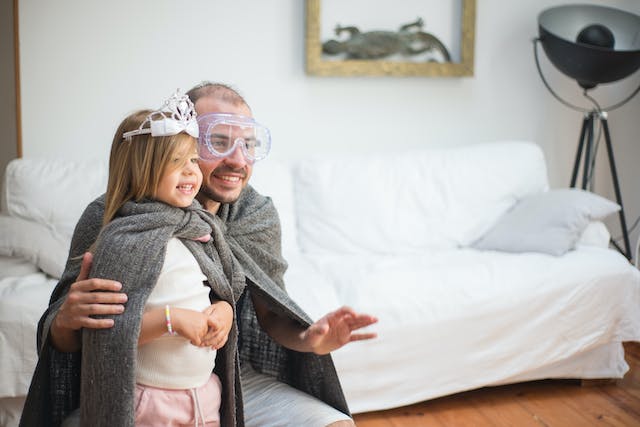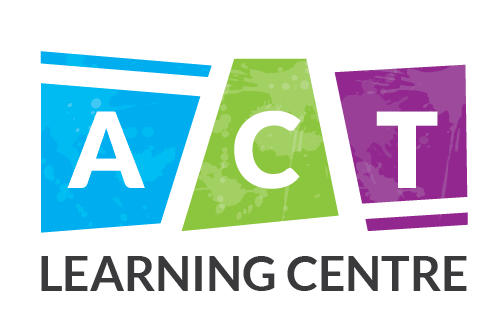Pretend Play & Communication Development
Building, Joining and Expanding Your Child’s Play
What is Pretend Play?
When it comes to childhood learning and development, the importance of play cannot be undersold! Research tells us, that “play is children’s work” (Lowry, 2016), meaning that kids will spend most of their time and energy on learning through fun. Play can look very different depending on the individual child and their interests. However, as children develop and begin to understand more complex concepts, to master new movements, and to expand their language, they also tend to begin more complex play. Pretend play is one of those later developing and more complex forms of play. In pretend play, children can re-live and practice real-world scenarios, create new experiences, and can practice navigating challenges relating to emotions, decisions, and conflict. Developing pretend play is associated with advancements in language skills, as children must represent more abstract concepts with their language.

Pretend play tends to develop in stages, beginning simple and realistic and increasingly becoming more complex and abstract/novel. As children’s language and cognitive skills develop, they become better equipped to think about symbols and meaning, in addition to concrete items. With this in mind, children tend to develop their pretend play following this trajectory (Lowry, 2016):
- Pretending/performing one action on themselves, using concrete objects that look like what they represent or are the real thing (e.g., pretending to drink from a cup, pretending to sleep on a pillow, pretending to eat a fake apple).
- Pretending/performing one action on another item, using concrete objects that are the real thing, or look like it (e.g., feeding a doll with a spoon).
- Pretending/Performing multiple actions related to a single theme, using concrete objects that are or look like the real thing (e.g., getting a pillow, getting a blanket, laying down and pretending to sleep). At this stage, children may be increasing their flexibility in what can represent the item, although stand-ins are often similar in size and shape to the real thing (e.g., using a ball as an orange).
- Role-playing multiple actions related to more diverse themes (e.g., Peppa Pig, fire fighter, hero, police officer, restaurant, or teacher…). Children at this stage may substitute items that do not at all resemble the real thing to represent items (e.g., a block for a cellphone or ball for a race car). Children may also pretend to use imaginary items, without the need for a stand-in (e.g., pretending to drink out of an invisible cup).
- Acting out more complex imaginary themes (e.g., pirates and wizards) without the need for concrete items to represent objects in the game. Language is particularly important at this stage of pretend play, as it is required to negotiate the rules, steps or roles in the game. Peers may become more involved in this stage of play.
Building on Pretend Play
Regardless of how your child is currently playing, there are ways that parents can help. Just by playing with your child, you are helping them practice several skills that are crucial to communication (such as joint attention, turn-taking, symbolic thinking, problem-solving etc.) (Sherred, 2021; Communication Community, 2023). It is important to follow your child’s lead so that the play is motivating and engaging to your child. If your child chooses a particular toy or play theme, just go with it. Some children have specific interests and may choose the same toys over and over. Challenge yourself to find new ways to engage in pretend play, even if your child wants the same toy or activity every time. For example, if they always want to play pirates, you can pretend to be a pirate with an eye patch and cover one eye, or you can add a new theme to the pirate game, such as being chased by a shark. Remember, there is no wrong way to play (Communication Community, 2023). Even if your child prefers to play alone, you can still narrate what they are doing, giving them the language that goes with their activity.
How Do I Join My Child’s Play?
Before you start to play with your child, first, just sit back and observe. Notice what they are interested in and what they are doing. Then, you can follow your child’s lead and join in. This might mean imitating them, helping them with their task, or adding some language to the play. Just remember not to change the play (Lowry, 2016). Using ‘naturalistic’ play has been shown to lead to better outcomes when trying to teach pretend play (Lowry, 2016). Some children may be difficult to engage with, especially if they are highly motivated by solitary sensory play. If your child is motivated by toys, try getting two sets of the same items so you can model pretend actions without taking your child’s toy away (Meaningful Speech, 2023). If you are looking to get your child specific toys to target pretend play, try to stick to toys that can be used in more than one way and ones that can be played with collaboratively (Lowry, 2016). Some ideas might include dolls, stuffed animals, puppets, blocks/Lego, toy food/dishes, vehicles, playdough, and costumes/props. You can also create opportunities for pretend play using common items around the house. For example, pots and pans can become musical instruments, linens and cushions can be made into a fort, things that roll (like tape, bottles, or paper towel/toilet paper rolls) can become vehicles to race (Lowry, 2016). With enough imagination, the possibilities are endless!
Pretending with People Play
Pretend play doesn’t need to include toys. When you aren’t using toys, you can create an unlimited number of ideas/themes. When engaged in people play, remember to R.O.C.K. (Lowry, 2016). This strategy keeps the game structured and predictable for your child. The acronym stands for ‘Repeat’ (repeat words, actions, and the game itself as many times as your child is motivated), ‘Opportunity’ (how your child takes a turn might look different each time. For example, they might use a word/sentence, make a sound, use a gesture, or share a look with you). ‘Cueing’ your child to take their turn can also look very different. It is important to use natural cues like pausing, waiting expectantly, or demonstrating what to do (model). Finally, ‘Keep’ the game fun and keep it going as long as your child is still interested. Some ideas for social people play pretend games include songs with actions (for example, the “This Little Piggy” nursery rhyme involves pretending your child’s fingers or toes are pigs), give your child a horsy ride on your back, hide-and-seek, tag, magic carpet ride, obstacle course, swinging, jumping/crashing, peek-a-boo, tickles etc.
Tips for Expanding Your Child’s Pretend Play:
- Show your child how to use different toys/objects during play. For example, they may not know what a lawn mower is – you can demonstrate it for your child. Then, once they are comfortable using it as intended, try a new idea with the toy (e.g., you are cutting a giant’s hair instead of grass).
- Create opportunities to role-play real life scenarios your child may have seen or done before (such as going to the grocery store, going to the dentist etc.). Try exposing your child to new experiences to introduce new play themes (Lowry, 2016).
- Demonstrate new actions your child can add to their repertoire (e.g., if they are pretending to feed a doll, you can then pretend the doll is sleeping or jumping). The goal is not to teach your child how to do the action, which can be less motivating and less effective (Lowry, 2016). Instead, prioritize creativity and fun while using new pretend play actions spontaneously.
Targeting Language Goals Through Pretend Play
Pretend play is an excellent way to target language and communication. Language and pretend play both involve symbols. In pretend play, we use one object to represent something else. Since words are symbols that represent various concepts, both skills are highly connected (Lowry, 2016). Even before children start to talk, pretend play encourages early communication skills such as joint attention and development of gestures (Lowry, 2016). Many SLPs use child-led, play-based therapy with their clients. This type of language intervention works because it is motivating, keeps the child’s attention, and teaches communication skills using naturalistic opportunities (Speech Therapy Works, 2022).
Ideas for Targeting Specific Language Goals
- Increase receptive language: practice following directions by role-playing a school theme (with a teacher/students) or follow the leader.
- Increase expressive vocabulary: as you play, label toys and other objects involved to help teach your child new words. If you are focusing on action words, cooking is a great play theme (you can model words like cut, chop, mix, stir, pour, shake, scoop etc.).
- Increase sentence length: practice expanding your child’s language while playing. Add one or two words to what your child says. For example, if you are pretending that you are camping and your child says “marshmallow”, you can say, “the marshmallow is gooey” or “let’s roast marshmallows”.
- Increase attention/turn-taking: when you find motivating pretend play activities, this can be a good opportunity to practice taking one more turn or staying in the game for another 30 seconds. Try to include novel, exciting elements (e.g., unexpected things happening in the play) to capture your child’s attention.
- If your child is a gestalt language processor (GLP): give your child more scripts they can use functionally. Some examples include, “it’s so fun”, “do it again”, “what’s next?”, “give it back”. Even single words can be gestalts, try modelling functional words like “more”, “go”, “all done” etc.
- Develop clearer speech sounds: (use characters to practice saying target words, make sounds for animals/vehicles etc.)
- Answering questions
Whether your child participates in speech therapy or not, there is still so much that parents can do at home. Parents know their children better than anyone. They spend the most time with their children during daily routines, which offers countless opportunities for communication. We hope these tips will help you feel more comfortable engaging in pretend play at home.
Written by: Lauren MacAulay, MHSc, SLP, Reg. CASLPO and Jane Woodworth, M.A. SLP-(C), Reg. CASLPO
References
Clark, C. (n.d.). How to use play to promote language development. Speech and Language Kids.
Microsoft PowerPoint – How to Use Play to Promote Language Development (speechandlanguagekids.com)
Communication Community. (2023). Boosting speech and language skills through play-based learning:
effective strategies for SLPs and parents. https://www.communicationcommunity.com/boosting-speech-and-language-skills-through-play-based-learning-effective-strategies-for-slps-and-parents/
Larrazabal, M. (n.d.). Importance of pretend play in your child’s development. Better Speech.
https://www.betterspeech.com/post/importance-of-pretend-play-in-your-child-s-development
Lowry, L. (n.d.). The land of make believe: How and why to encourage pretend play. Hanen. https://www.hanen.org/helpful-info/articles/the-land-of-make-believe.aspx
Lowry, L. (n.d.). Pretend play should be fun, not work! Hanen.
https://www.hanen.org/Helpful-Info/Articles/Pretend-play-should-be-fun.aspx
Lowry, L. (2019). Does pretend play set the stage for early communication? Hanen. Chrome-extension://efaidnbmnnnibpcajpcglclefindmkaj/https://www.hanen.org/SiteAssets/Articles—Printer-Friendly/Research-in-your-Daily-Work/Does-pretend-play-set-the-stage-for-early-communic.aspx
Lowry, L. (n.d.). Research reveals the power of pretending. Hanen.
https://www.hanen.org/Helpful-Info/Articles/New-Research-Reveals-the-Power-of-Pretending.aspx
Lowry, L. (n.d.). Thinking outside the toy box. Hanen.
https://www.hanen.org/Helpful-Info/Articles/Thinking-Outside-the-Toy-Box.aspx
Play-based therapy. (n.d.). Speech Therapy Works.
Play and gestalt language processors. (2023, November 02). Meaningful Speech.
https://www.meaningfulspeech.com/blog/play-and-glp
Pretend play developmental milestones. (n.d.). Occupational Therapy Helping Children.
ROCK: in people play games: building communication in children on the autism spectrum or with social communication difficulties. (n.d.). Hanen.
https://www.hanen.org/Helpful-Info/Articles/R-O-C-K–in-People-Games–For-Children-with-ASD-or.aspx
Sherred, L. (2021, March 03). Using play to promote speech and language development. Expressable.
https://www.expressable.com/learning-center/babies-and-toddlers/using-play-to-promote-speech-and-language-development
Srividya, K. (n.d.). Stages of pretend play. Headstreams. https://headstreams.org/stages-of-pretend-play/


